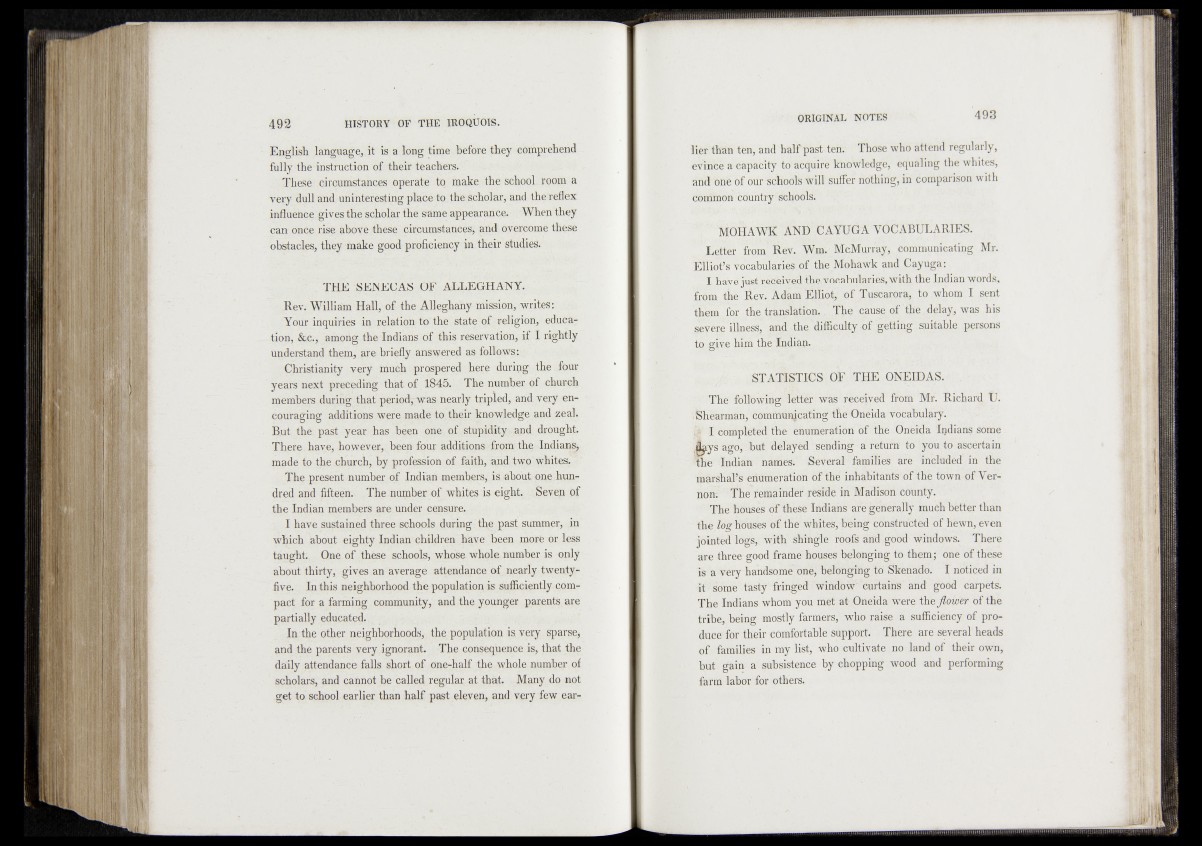
4 9 2 HISTORY GF THE IROQUOI§.
English language} it is. a long time before they comprehend
fully the instruction of their teachers-'
These circumstances operate to make the schooLroom a
very dull and unintefcstihg plnce to. the Scholar, and the reflex
influence gives the scholar the same appearance, Whepthtsy
can once rise above these circumstances, and overcome these
obstacles, they make good proficiency in their stuejies.
THE SENECAS OF ALLEGHANY. '
Rev. William Hall, of the Alleghany mission, writes: j,
Your inquiries in relation to the state of religion, educa^
lion, &c., among the Indians of this reservation, if I rightly
understand them, are briefly answered as follows:-:
Christianity very much prospered .here during the four
years next preceding that of 1845. The number of church
members during that periody was-nearly tripled, and vqjy mi-
couraging additions were made to their knowledge and zeal.
B,ut the. past year has been one q£,tstupidity ,apd drought.
There have, however, been four additions*'from the Indians^
made to the church, by profession of faith, and two whites. |
The present number of Indian members,. is about ope hundred
and fifteen. The nupaherof whites is eight, „jpeveri of
the Indian members are, under censure. •
I have sustained three schools during the past summer, .in
which about eighty Indian children have* been morfe or less
taught. One of these schools, whose, whole, number is only
about thirty, gives .an average attendance of nearly twenty-
five. In this neighborhood the population is sufficiently compact
for a farming community, and the younger parents are
partially educated.
In the other neighborhoods, the population is, very., sparse,
and the parents very ignorant. The consequence is, that the
daily attendance falls short of One-half the whole number of
scholars, and cannot be called regular at that. Many do not
get to sehool earlier than half past eleven, and very few ear-
ORIGINAL NOTES 493
lier than tfen, and halfpaeCten.- Those who attend regularly,
evince a capacity io''acquire khoWlpdge, equaling the whites,
aud'bbh 6f our schools Mil suffer nothing, in comparison with
common OTuhtty' schools.
V4MoHAWK AND CAYUGA VOCABULARIES.
Letter "frqmfRey,(1Wm. McMprray, communicating; Mr.
Elliots vSthularfes -off the Mohawk and . Caypga:.
I have j^treceivfij -the,vocabularies, with the Indian words,
from the iW Adapi EHibf, ofTpseproraj to whom I sent
t h e m S ’ih.e translation.. The .cause of'the delay, was his
^ye^^lpiess, pnd . t h o ^ ^ f e ^ f 'g e f ip g suitable persons
to give him the Indiap.t
, ^STATISTICS. OF THE ON^IDAS.-
-v The fbltewlng 'fetter waS* ifepetyed from Mr. Richarji u.
Shearman, commuqjcating the Oneida vocabulary.
T coMpleted the- ^uMeratfon of the Oneida Indians some
Jjiysago, but delated ‘’sending a refunr to"you-to ascertain
The Indian names. Several ‘ families are included in the
marshal’s enumeration o f the inhabitants1 of the town of Vernon;
The remainder reside in Madison county.-
The houses oTtfieSe Indians are generally touch better than
the foghhiJses of the whites, being constructed- of hewn, even
jointed logs, with shihgte roofs arid gOod windows. There
are three-good frame- houses belonging; to thpm; one of these
is-a very handsome one, belonging to Skenado. I noticed in
ut some tasty fringed r-Wihd6# Curtains and good carpets.
The Indians whom you met at- Oneidawere the flower of the
tribe, being mostly farmers," who raise a sufficiency of produce1
for their comfortable support. There are several'heads
of families in my list, who cultivate no land of their own,
| hut' • gain a subsistence by chopping wood and performing
farm labor for others.